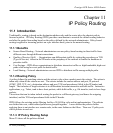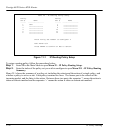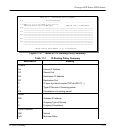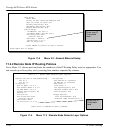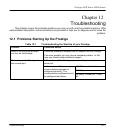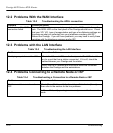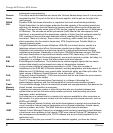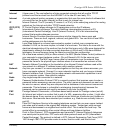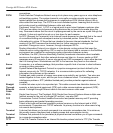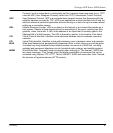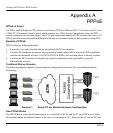
Prestige 642R Series ADSL Router
Glossary A
Glossary
10BaseT
The 10-Mbps baseband Ethernet specification that uses two pairs of twisted-pair cabling
(Category 3 or 5): one pair for transmitting data and the other for receiving data.
ADSL
Asymmetrical Digital Subscriber Line is an asymmetrical technology, meaning that the
downstream data rate is much higher than the upstream data rate. ADSL operates in a
frequency range that is above the frequency range of voice services, so the two systems can
operate over the same cable.
ARP
Address Resolution Protocol is a protocol for mapping an Internet Protocol address (IP
address) to a physical machine address that is recognized in the local network.
Backbone
A high-speed line or series of connections that forms a major pathway within a network.
Bandwidth
This is the capacity on a link usually measured in bits-per-second (bps).
Bit
(Binary Digit) -- A single digit number in base-2, in other words, either a 1 or a zero. The
smallest unit of computerized data.
Byte
A set of bits that represent a single character. There are 8 bits in a Byte.
CDR
Call Detail Record. This is a name used by telephone companies for call related information.
CHAP
Challenge Handshake Authentication Protocol is an alternative protocol that avoids sending
passwords over the wire by using a challenge/response technique.
Client
A software program that is used to contact and obtain data from a Server software program
on another computer. Each Client program is designed to work with one or more specific
kinds of Server programs, and each Server requires a specific kind of Client. A Web Browser
is a specific kind of Client.
Crossover
Ethernet
Cable
A cable that wires a pin to its opposite pin, for example, RX+ is wired to TX+. This cable
connects two similar devices, for example, two data terminal equipment (DTE) or data
communications equipment (DCE) devices.
CSU/DSU
Channel Service Unit/Data Service Unit. CSUs (channel service units) and DSUs (data
service units) are actually two separate devices, but they are used in conjunction and often
combined into the same box. The devices are part of the hardware you need to connect
computer equipment to digital transmission lines). The Channel Service Unit device connects
with the digital communication line and provides a termination for the digital signal. The Data
Service Unit device, sometimes called a digital service unit, is the hardware component you
need to transmit digital data over the hardware channel. The device converts signals from
bridges, routers, and multiplexors into the bipolar digital signals used by the digital lines.
Multiplexors mix voice signals and data on the same line.
DCE
Data Communications Equipment is typically a modem or other type of communication
device. The DCE sits between the DTE (data terminal equipment) and a transmission circuit
such as a phone line.
DHCP
Dynamic Host Configuration Protocol automatically assigns IP addresses to clients when they
log on. DHCP centralizes IP address management on central computers that run the DHCP
server program. DHCP leases addresses for a period of time which means that addresses are
made available to assign to other systems.
DNS
Domain Name System links names to IP addresses. When you access Web sites on the
Internet, you can type the IP address of the site or the DNS name. When you type a domain
name in a Web browser, a query is sent to the primary DNS server defined in your Web
browser’s configuration dialog box. The DNS server converts the name you specified to an IP
address and returns this address to your system. From then on, the IP address is used in all



